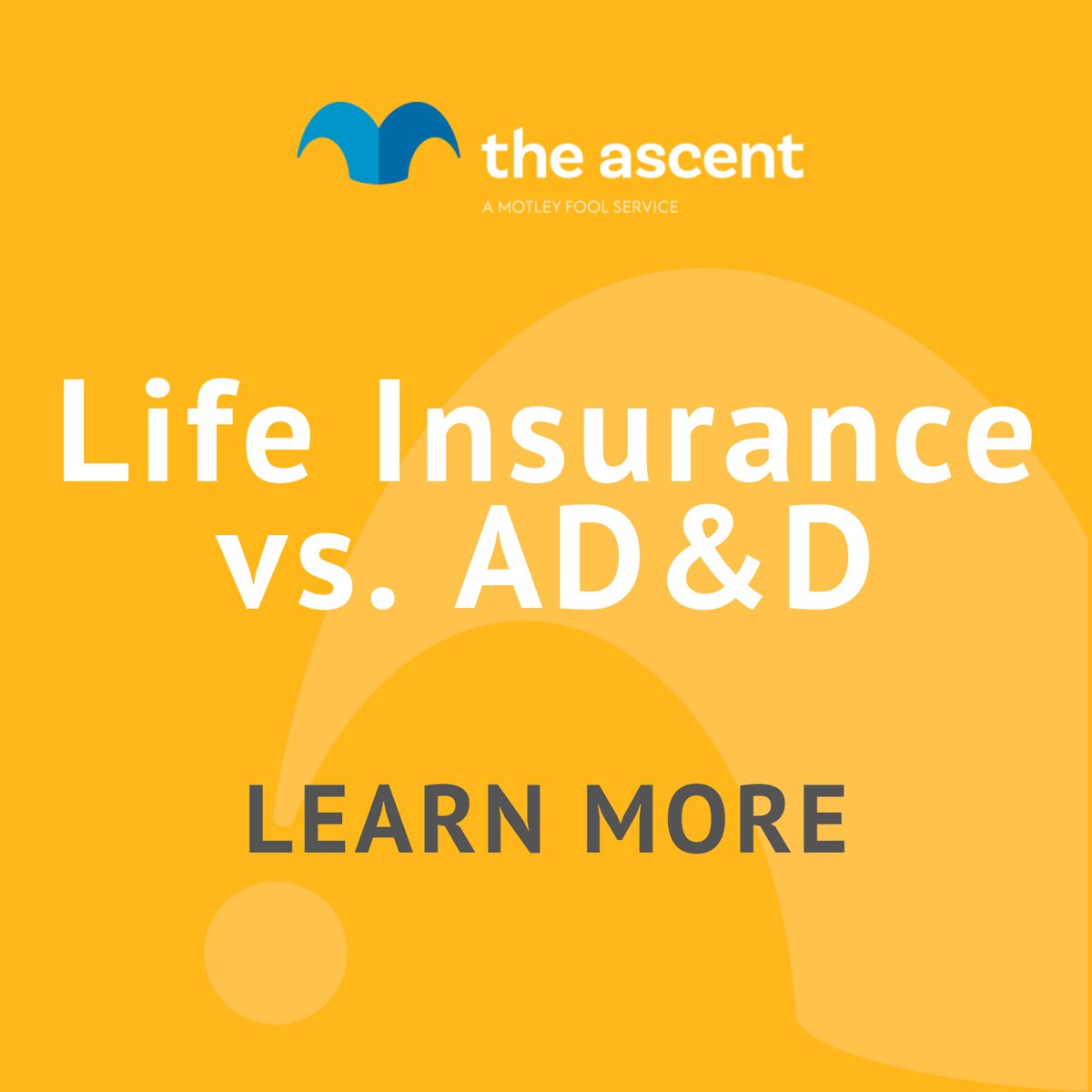Introduction
Life insurance and AD&D insurance are two important types of insurance that can provide financial protection for you and your family. Life insurance provides a death benefit that can help cover funeral expenses, outstanding debts, and other financial obligations. AD&D insurance provides a benefit if you are injured or killed in an accident.
The purpose of this comparison is to help you understand the differences between life insurance and AD&D insurance so that you can make informed decisions about which type of insurance is right for you.
Coverage
Life insurance and AD&D insurance are distinct types of insurance policies that offer different coverage for different situations.
Life Insurance Coverage
Life insurance provides a financial payout to beneficiaries upon the death of the insured person. This payout can be used to cover expenses such as funeral costs, outstanding debts, or lost income.
AD&D Insurance Coverage
AD&D insurance (Accidental Death and Dismemberment insurance) provides a financial payout if the insured person dies or suffers a dismemberment due to an accident. This coverage is typically provided as a supplement to life insurance and does not cover deaths or dismemberments resulting from natural causes.
Scope and Limitations
Life insurance offers broader coverage, providing a payout for any cause of death. AD&D insurance, on the other hand, has a narrower scope, only covering deaths or dismemberments resulting from accidents.
Life insurance typically has higher coverage limits than AD&D insurance, which may have limitations on the amount of payout for specific types of accidents.
Benefits
Life insurance and AD&D insurance both provide financial protection in the event of an unexpected event. However, they offer different types of coverage and benefits.
Life insurance provides a financial benefit to your beneficiaries upon your death. This can help them cover funeral expenses, pay off debts, or maintain their standard of living. AD&D insurance provides a financial benefit if you are killed or disabled in an accident. This can help you cover medical expenses, lost wages, or other costs associated with the accident.
Financial Benefits
- Life insurance provides a financial benefit to your beneficiaries upon your death.
- AD&D insurance provides a financial benefit if you are killed or disabled in an accident.
Non-Financial Benefits
- Life insurance can provide peace of mind knowing that your loved ones will be financially secure in the event of your death.
- AD&D insurance can provide peace of mind knowing that you will be financially protected in the event of an accident.
Cost

The cost of life insurance and AD&D insurance varies depending on several factors. These factors include the insured’s age, health, occupation, and coverage amount.
Life Insurance Cost
The cost of life insurance is typically determined by the insured’s age, health, and coverage amount. Younger and healthier individuals generally pay lower premiums than older and less healthy individuals. The coverage amount also affects the cost of life insurance, with higher coverage amounts resulting in higher premiums.
AD&D Insurance Cost
The cost of AD&D insurance is typically determined by the insured’s occupation and coverage amount. Individuals in high-risk occupations, such as construction workers or police officers, generally pay higher premiums than individuals in low-risk occupations. The coverage amount also affects the cost of AD&D insurance, with higher coverage amounts resulting in higher premiums.
Premiums and Deductibles
Premiums are the regular payments made to maintain an insurance policy. Deductibles are the amount of money that the insured must pay out of pocket before the insurance company begins to cover expenses.
Life insurance premiums are typically paid monthly or annually. AD&D insurance premiums are typically paid annually.
Life insurance policies typically have no deductibles. AD&D insurance policies may have deductibles, which can vary depending on the policy.
Eligibility
Life insurance and AD&D insurance have different eligibility requirements. To qualify for life insurance, you must be of insurable age, usually between 18 and 65, and in good health. You must also have an insurable interest in the person whose life you want to insure, meaning that you would suffer a financial loss if that person were to die.
AD&D insurance, on the other hand, is typically available to anyone who is actively employed. There is no age or health requirement, and you do not need to have an insurable interest in the person you want to insure.
The main factor that affects eligibility for life insurance is your health. If you have a serious medical condition, you may be denied coverage or you may have to pay a higher premium. The main factor that affects eligibility for AD&D insurance is your occupation. If you work in a high-risk occupation, you may be denied coverage or you may have to pay a higher premium.
Factors Affecting Eligibility
There are a number of factors that can affect your eligibility for life insurance, including:
* Age
* Health
* Occupation
* Lifestyle
* Family history
There are also a number of factors that can affect your eligibility for AD&D insurance, including:
* Occupation
* Age
* Health
* Lifestyle
Riders and Endorsements
Riders and endorsements are optional add-ons that can be attached to life insurance and AD&D insurance policies to provide additional coverage and benefits. These add-ons can enhance the protection provided by the base policy, tailoring it to meet specific needs and circumstances.
Life Insurance Riders and Endorsements
Life insurance riders and endorsements can provide coverage for a range of additional events or circumstances, such as:
– Accidental death benefit: Provides additional coverage in the event of an accidental death.
– Waiver of premium rider: Waives premium payments if the insured becomes disabled.
– Guaranteed insurability rider: Allows the insured to purchase additional coverage at predetermined intervals without having to undergo medical underwriting.
AD&D Insurance Riders and Endorsements
AD&D insurance riders and endorsements can also provide additional coverage for specific events or circumstances, such as:
– Common carrier accident benefit: Provides coverage for accidents involving common carriers, such as airplanes, trains, and buses.
– Terrorism rider: Provides coverage for injuries or death resulting from acts of terrorism.
– Sports rider: Provides coverage for injuries or death resulting from participation in specific sports activities.
Comparison of Riders and Endorsements
The specific riders and endorsements available for life insurance and AD&D insurance policies vary depending on the insurance company. However, they generally provide similar types of additional coverage and benefits. When comparing riders and endorsements, it’s important to consider the following factors:
– Coverage: What specific events or circumstances are covered by the rider or endorsement?
– Benefits: What additional benefits are provided by the rider or endorsement?
– Cost: How much does the rider or endorsement cost?
– Eligibility: Who is eligible to purchase the rider or endorsement?
By carefully considering these factors, individuals can determine which riders and endorsements are right for their specific needs and circumstances.
Claims Process
Filing a claim for life insurance or AD&D insurance involves specific procedures and timelines. Understanding the claims process for each type of insurance can help you navigate the process efficiently.
In general, the claims process for both life insurance and AD&D insurance involves the following steps:
- Notifying the insurance company: Report the death or dismemberment to the insurance company as soon as possible.
- Submitting a claim form: Obtain a claim form from the insurance company and provide the necessary information, such as the policyholder’s name, policy number, and details of the incident.
- Providing documentation: Submit supporting documents, such as a death certificate, medical records, or police reports, to substantiate the claim.
- Insurance company review: The insurance company will review the claim and may request additional information or documentation.
- Settlement: If the claim is approved, the insurance company will issue a settlement payment to the beneficiary or policyholder.
Life Insurance Claims
The claims process for life insurance typically involves the following timelines and procedures:
- Timelines: The insurance company has a specified period, usually 30-60 days, to process the claim after receiving all necessary documentation.
- Documentation: In addition to the claim form, the insurance company may request a certified death certificate, medical records, and proof of identity for the beneficiary.
- Procedures: The insurance company may conduct an investigation to verify the cause of death and ensure that the policy is valid.
AD&D Insurance Claims
The claims process for AD&D insurance may vary slightly from life insurance claims:
- Timelines: The insurance company may have a shorter processing period for AD&D claims, typically around 15-30 days.
- Documentation: Along with the claim form, the insurance company may request medical records, police reports, or other documentation related to the accident or dismemberment.
- Procedures: The insurance company may require a more thorough investigation to determine if the injury or dismemberment meets the policy’s definition of AD&D.
In summary, both life insurance and AD&D insurance have specific claims processes with varying timelines and documentation requirements. Understanding the claims process can help you navigate the process smoothly and ensure a timely settlement.
Conclusion
Life insurance and AD&D insurance are both important financial tools that can provide peace of mind and financial security for you and your loved ones. However, they serve different purposes and have different features and benefits.
Understanding the key differences between these two types of insurance is crucial to make informed decisions about which one is right for you. Consider your individual needs, circumstances, and financial goals to determine the best course of action.
Here’s a summary of the key differences between life insurance and AD&D insurance:
– Purpose: Life insurance provides financial protection in the event of your death, while AD&D insurance provides financial protection in the event of your accidental death or dismemberment.
– Coverage: Life insurance typically provides a death benefit that is paid to your beneficiaries upon your death. AD&D insurance provides a benefit that is paid to you if you suffer an accidental injury or death.
– Benefits: Life insurance can provide a lump sum payment to your beneficiaries, which can be used to cover funeral expenses, pay off debts, or provide income replacement. AD&D insurance can provide a lump sum payment to you to cover medical expenses, lost income, or other expenses related to your injury or death.
– Cost: Life insurance is typically more expensive than AD&D insurance. The cost of life insurance will depend on your age, health, and the amount of coverage you purchase. The cost of AD&D insurance will depend on your occupation and the amount of coverage you purchase.
– Eligibility: Life insurance is available to most people. AD&D insurance is typically only available to people who are employed in certain occupations or who participate in certain activities.
– Riders and Endorsements: Both life insurance and AD&D insurance can be customized with riders and endorsements to provide additional coverage.
– Claims Process: The claims process for life insurance and AD&D insurance is similar. You will need to file a claim with the insurance company and provide documentation to support your claim.



